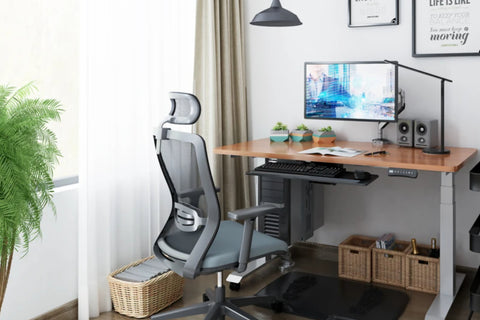The costs of setting up a home office for remote work
 GroWrk Team
GroWrk Team
Once you decide to equip your remote employees' home offices, the two main questions are always about cost and logistics. Equipment for remote workers needs to be high quality to ensure employees are safe and happy, but accessible enough so that you can manage your budget. Once you pick the furniture and equipment you’ll be wondering how to ship, deliver and manage it. Which employees get what, when and where.
You might be thinking: how can I research the specific expenses for my company? Home office equipment and office supplies can vary significantly based on the location, number, and hierarchy of the employees. With so much variety, crunching the numbers can only give us averages at best.
Putting a blanket number on average home office costs for employees is hard. Finding the time to make the process run smoothly, looking for the right vendors, setting up budgets for employees, transferring the money and processing reimbursements make it even more complicated.
However, you can use these guidelines to help make the process a lot easier. Use our advice to calculate the costs of providing this benefit for your remote workers and determine the equipment that they need to work safely and comfortably long-term.
You’ll also learn about some money-saving options that will help navigate your company through this transition to hybrid or fully remote work.
Step one: what do your employees need?
The first thing you can do is think about your headquarters or physical office. What kinds of things did your employees have there? Try to be as specific as possible. Did every employee’s desk have an ergonomic keyboard? What type of desk and chair did you pick? Why did you choose those?
The headquarters is the perfect place to determine the standard for remote workers because you want all of your employees to be on a level playing field.
The headquarters is the perfect place to determine the standard for remote workers because you want all of your employees to be on a level playing field. If a remote employee doesn’t have equipment at their house that a regular office employee would have at their desk, it is absolutely a disadvantage. Remote workers can often feel underappreciated because they don't have the same dedicated workspace and equipment compared to people working in a building.
Another important way to start is to send out a survey to your employees. You can then turn the roll call survey into a list of essential workplace items.
- “What office supplies do you already have at your home?”
- “What items do you want for your home office?”
- "What is one piece of furniture or equipment that needs an upgrade?"
Communication is a vital component of employee satisfaction. If your employees are struggling with working from home or their home office was underprepared for remote work, they can voice it in the survey. The COVID-19 crisis left many people working from home for the very first time. A living room or a spare bedroom were quickly turned into a makeshift remote workspace. Many people have adjusted by now but your employees will appreciate the effort you are making and it will build trust within the company.
Some employees may even fear "daring" to request extra benefits in these straining times. It’s crucial for HR departments and management to be proactive and open the line of communication so employees can submit their requests and concerns without fear of repercussion or rejection.
Step two: Determine a budget
Before setting out to give your employees everything they need, you must make sure your company can afford it. With the wrong benefits package, it can be extremely expensive to outfit every remote employee equally.
Before setting out to give your employees everything they need, you must make sure your company can afford it.
You might also have remote employees who perform very minimal and infrequent tasks or work on a part-time basis. Surely, these employees don’t require the same productive workspace investment as a full-time employee performing fundamental processes for the company. That’s why the first step in determining your budget is deciding what everybody needs to perform their job effectively.
The essential remote workers work for you full time (40+ hours per week). These are the employees who are most likely to require a fair budget for their home offices. They are probably a vital part of your company. You want to keep them happy and have them avoid any long-term health effects of working with inadequate furniture and equipment. If you don't take action you could possibly open yourself up to worker compensation claims or an injury lawsuit.
The perfect and complete home office set we recommend consists of a sit-stand desk, laptop, monitor, mouse, keyboard, laptop stand, and an ergonomic chair. If we break this down, it could look something like this:
- Sit-Stand desk- $500
- Ergonomic chair- $350
- Mac book Air M1, 8GB RAM + 22-inch screen- $1000
- HP 22-inch screen- $150
- Wireless mouse- $30
- Ergonomic keyboard- $50
- Total: $2080
For part-time employees, we would recommend providing equipment on a task basis. If needing a recent computer model is important to using the company’s systems and software, then giving them a work laptop from the last 3 years is something to consider.
However, if they are freelancers, you probably don’t have to concern yourself with the chair they’re sitting in or any other equipment.
Next, you’ll have to consider available funds. This is pretty specific to your company. However, we can give some suggestions on freeing up money for remote worker office equipment. Maybe you have a benefit like lunch coupons or public transportation passes that aren’t as useful in a hybrid or fully remote work setting.
Consider replacing these benefits with remote ones. You can also use the money you’re saving on office space rent to equip your employees properly.

Step three: How will you get the equipment to your remote workers
If your remote employees are international or very far apart domestically, it is a huge logistical undertaking to send them each one a sit-stand desk or any other piece of equipment, including essential things such as laptops. That’s why the first step in distributing office furniture and equipment to your employee’s homes is a lot like the golden rule of real estate: location, location, location.
If all your remote workers are nearby headquarters or in a large city, this process is relatively simple. Furniture and equipment can be delivered locally, distributed by employees or delivery staff (like truck drivers), or even picked up by the workers themselves.
For workers that are farther away in small cities or other countries, the problem gets a lot more complicated. International and state to state shipping costs can be a nightmare for companies and often will be more expensive than the equipment itself.
When considering the diversity of prices in each country it can also be a problem to develop a basic package for all remote employees. What it might cost to order a German worker from one of their local providers can cost a lot less for a Mexican remote worker. This also leads to confusion when determining an overall budget for teleworkers in an international company.

Conclusion
Every company is different, but some things will never change. Keeping your employees safe and satisfied is the best way to evolve as a company and keep producing and profiting efficiently in the long-term. You’re investing in the future of your company.
Providing these benefits will lead to employee retention and seasoned employees with a lot of experience is exactly what brings success in business. Not only that, but you’ll climb to the top of the list in remote work recruitment, attracting star-studded candidates to join your team.
Using the steps above, you can take a wide-spread and individual-based assessment of your remote office needs. By picking the necessary equipment, finding/clearing your budget, picking a distribution channel, and choosing the best home office equipment management company, you can get through this process successfully no matter where your team is working from.




.png)


